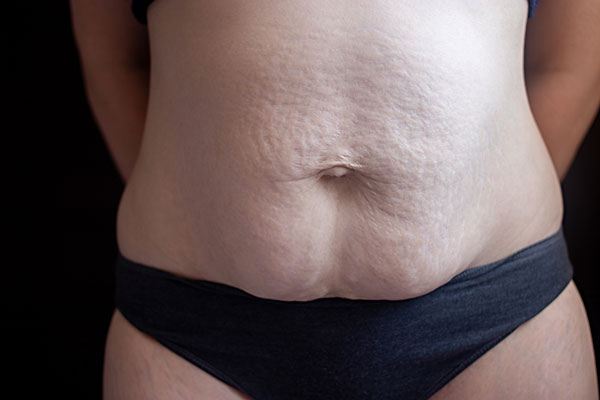Diastasis Recti Repair Surgery
What is diastasis recti?
Diastasis recti is when the abdominal muscles separate and is frequently brought on by pregnancy or large weight changes. Abdominal separation diastasis recti can also be caused by recent abdominal surgeries, traumatic injuries, or congenital defects. Diastasis recti repair surgery restores the abdominal wall by stitching the divided muscles to help improve the strength, function, and appearance of the abdomen. Dallas board-certified plastic surgeons Dr. Solomon Azouz and Dr. David Azouz have treated thousands of patients with diastasis recti with surgery to help restore the structure and contour of the abdomen.


What are the symptoms of diastasis recti?
Diastasis recti, also known as abdominal separation, occurs when the two muscles running down your midline (“six-pack”) separate slightly. This is rather typical, particularly after pregnancy, when the developing baby stretches your tummy. When you activate your core, it may generate a noticeable bulge or “pooch.” Diastasis recti can also result in back pain, core weakness, trouble doing specific activities, difficulty lifting objects, walking, pelvic pain, or hip pain. During certain movements, your abdomen may protrude outward rather than flatten. Some patients also report poor posture, difficulties with everyday tasks, or even incontinence caused by weakened pelvic floor muscles. Other symptoms also include bloating, a weak core, and general discomfort.
Types of diastatis recti





Who is a candidate for diastasis recti repair surgery?
There are some nonsurgical treatment options for diastasis recti including physical therapy, lifestyle modifications, or certain exercises. A physical therapist can create a tailored workout regimen aimed at strengthening your core muscles, particularly the pelvic floor muscles. They’ll show you safe and effective ways to engage your core without straining the separation. While not a permanent solution, wearing an abdominal binder during specific activities such as lifting or exercising can give temporary support and relieve pressure on the abdominal wall. However, many patients continue to suffer from diastasis recti after trying non-surgical measures like physical therapy and focused exercises are good candidates for diastasis recti correction surgery.
Diastasis Recti Postpartum
One common condition that can arise during or after pregnancy is diastasis recti. The growing uterus puts a lot of pressure on the abdominal muscles during pregnancy. Chronic stress can cause the rectus abdominis muscles to separate, which can lead to diastasis recti. It normally begins around the abdomen’s midline, below the navel. After giving birth, diastasis recti may persist. It is recommended to consult a healthcare expert, like board-certified plastic surgeon Dr. Azouz for a correct diagnosis and guidance on activities to promote healing and recuperation.

Benefits of Diastasis Recti Surgery
Diastasis Recti Repair Surgery has several advantages, such as better core stability, stronger abdominal muscles, decreased back pain, and the restoration of a more toned, flatter abdomen.
- Some degree of abdominal muscle separation occurs during or after pregnancy in nearly two thirds of pregnant women.
- Diastasis recti may continue after childbirth
- Men can also develop diastasis recti
Diastasis Recti Treatment Surgery
An abdominal incision is made as part of the surgical operation to reach the divided muscles. The separated abdominal muscles are then stitched together, tightening and stabilizing the abdominal wall. Dr. Azouz uses cutting-edge methods to guarantee the best outcomes with the least amount of scarring.

What is the anesthesia for diastasis recti repair surgery?
Dallas plastic surgeon Dr. Solomon Azouz avoids the use of general anesthesia to minimize postoperative nausea and common side effects from general anesthesia. Dr. Azouz uses sedation to help keep patients comfortable during the procedure. Local anesthesia is also used to control pain, which can help for up to 24 hours after the procedure.
What are the risks of surgery?
As with any surgical operation, diastasis recti repair surgery carries some potential risks. These could include bleeding, infection, and scarring. During the pre-operative appointment, Dr. Azouz will go over these risks in detail with each patient.
What is the recovery from diastasis recti surgery?
Following surgery, patients recovering from diastasis recti correction must rest and limit physical activity. Throughout a few weeks to months, patients should anticipate a progressive development in their abs’ strength and look.
What other procedures can be combined with diastasis recti repair surgery?
To accomplish a complete abdominal rejuvenation, diastasis recti repair surgery may occasionally be coupled with additional treatments like liposuction or abdominoplasty (tummy tuck). To select the best surgical plan, Dr. Azouz will evaluate each patient individually for a personalized plan to meet each goal.
What is the cost of surgery?
The cost for diastasis recti repair surgery may differ depending on many factors such as the surgical fee, anesthesia fee, facility fee, and any necessary equipment. Dallas plastic surgeon Dr. Azouz offers individual consultations to go over prices, modes of payment.
Schedule your consultation with Dr. Azouz

FAQs
Normally a small diastasis recovers within four to eight weeks of pregnancy. However, a larger diastasis may take six to twelve months.
Sometimes diastasis recti can heal on its own. Other women may need to seek treatment. Physical therapy and exercise can be options for treatment, however, surgery help to provide the best long-term solution to help join the separated abdominal muscles.
If you have a weakness in the connective tissue, it is more likely to happen again, but diastasis recti isn't something that should discourage a patient from becoming pregnant again.
When pregnant or recovering from diastasis recti, it's important to avoid exercises that place pressure on the abdominal muscles. It is best to seek advice from an expert like Dr. Azouz to prevent further injury of the abdominal muscles.
Some women will have less severe diastasis recti, while others will have significant cases that can't be corrected through any other means. Surgery should be considered for women whose abdominal muscle weakness is interfering with their daily activities.
